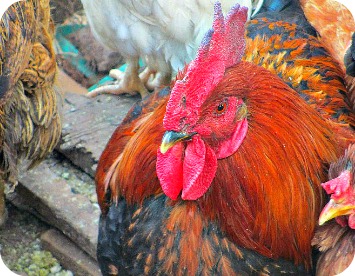Kuroiler Chicken could be your better bet than raring indigenous breeds in Uganda
by Admin

Kuroiler Chicken in Uganda
A Kuroiler Chicken is a chicken breed with indigenous traits which grows faster and lays more eggs than the local chicken, this chicken breed has been introduced in Uganda. Kuroilers were first successfully introduced in India more than a decade ago. The birds are low-maintenance scavengers that thrive on household and agricultural waste.
How Kuroiler Birds Came to Uganda
The Kuroiler breed originated from Kegg Farms in India and is now available on the Uganda Market. “On July 12, 2010, the first Kuroiler chicks were hatched in Entebbe. On the same day, indigenous chicken were hatched,” says Dr. Daniel Ssemambo, the executive director of National Animal Genetic Resources Centre and Data Bank (NAGRC & DB). NAGRC & DB is an organisation, under the agriculture ministry, that supports the implementation of the national breeding policy.
According to Ssemambo, the first move was to find out how the Kuroilers faired against local breeds. “We hatched Kuroilers and local breeds on the same day,” he says. “The two breeds were given to chicken farmers in Kabale, Gulu, Apac, Mayuge and Wakiso districts under a pilot project to assess which variety performed better.
The farmers testified that the Kuroilers grew faster, putting on 1kg for hens and 1.5kg for cocks by three months and 3kg and 4kg respectively by six months.
Just like the local breeds, the Kuroilers are largely kept under a free range system, where the birds are left to scratch for food with no restrictions and very little or no supplements.
“The difference is that while the locals are moderate while scratching for food and may even take a rest, Kuroilers are aggressive and feed continiously. This explains why they put on weight faster than the local breeds,” says Esau Galukande, the NAGRC technical manager, who also took part in the research.
Kuroiler Birds on Uganda Farms
A farmer in Wakiso district said the birds grow faster, produce more and bigger eggs.
Compared to hybrids, the egg-yolk is even more yellowish, hence more nutritious. The fact that this farmer kept the chicken successfully in a semi-urban environment is a pointer to their big potential.
“I package the eggs in sets of half a dozen and sell them in supermarkets. A tray goes for sh10,000 compared to sh6,000 for hybrid eggs,” said Betty Ssewanyana, a farmer in Entebbe. Ssewanyana said while the mortality of local chicken is high, all the 23 Kuroiler chicken she got grew.
According to Dr. James Ongu, a veterinary officer from Apac, who undertook the development of the Kuroilers in the area, the growth and survival straits they exhibited against the local breed were high. “This area is largely chicken-producing and this breed is set to revolutionise and ease chicken rearing,” he said.
Asked if they could be crossed with indigenous chicken, Dr Vinod Kapur, from Kegg Farms said it was not advisable if a farmer wanted to maintain quality. Kapur said Kegg Farms would start distributing the chicken in Uganda.
Ssemambo said the chicken had a very big potential of improving nutrition in Uganda. The breed was launched in Entebbe recently.
Advantages of Kuroiler Chicken
Basically it has all the advantages of local chicken but they grower faster and produce more eggs which also have a yellow york. You can put them under a free range or you can build a house for them but their feeding is not as strict as the broilers and layers.
The Kuroiler chickens offer a significant improvement in virtually all areas of breeding. While indigenous chickens lay just 30-40 eggs per year, the Kuroilers can easily produce five times that number or around 150-200. Kuroilers also grow to about double the body weight of their native counterparts, providing much more edible meat.
Compared to hybrids, the egg-yolk is even more yellowish, hence more nutritious. The fact that this farmer kept the chicken successfully in a semi-urban environment is a pointer to their big potential.
Kroiler hens mature between two and four months and weigh between 2 and 3 kilograms. At three months, the hens start laying eggs continuously for two years. A mature Kroiler cock weighs between 4 to five kilograms. Kroiler chicks are more resistant to diseases and can easily be treated by mixing vitamins, feeds and water.
Just like the local breeds, the Kuroilers are largely kept under a free range system, where the birds are left to scratch for food with no restrictions and very little or no supplements.
The difference is that while the locals are moderate while scratching for food and may even take a rest, Kuroilers are aggressive and feed continuously. This explains why they put on weight faster than the local breeds
To buy Kuroiler Birds Click ON this Link.Related Pages





